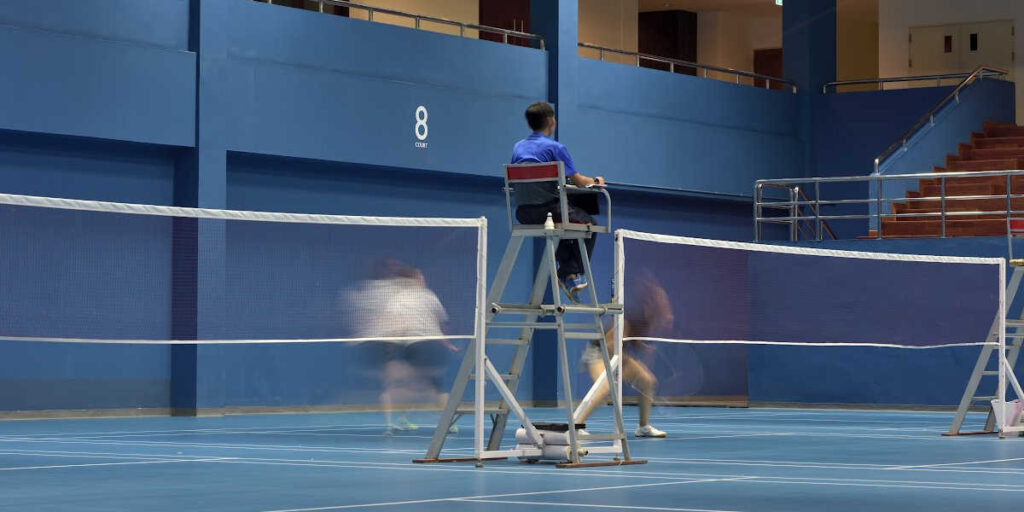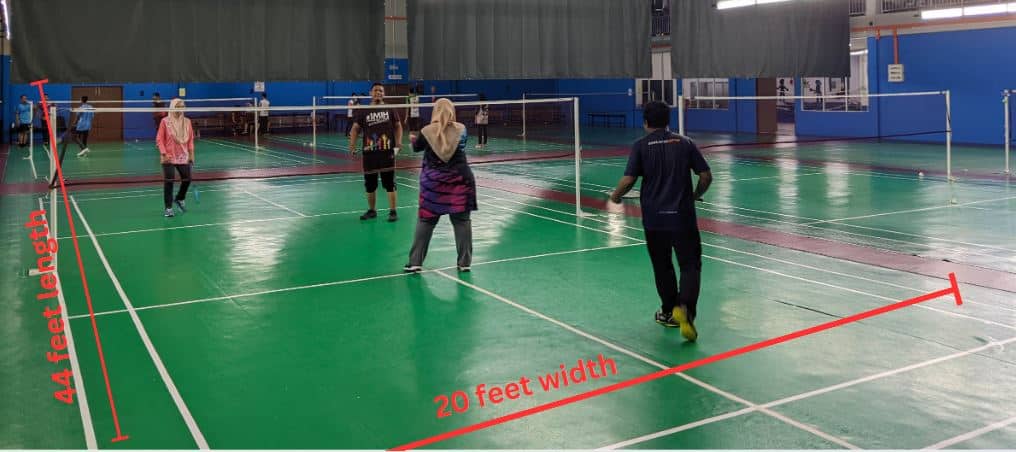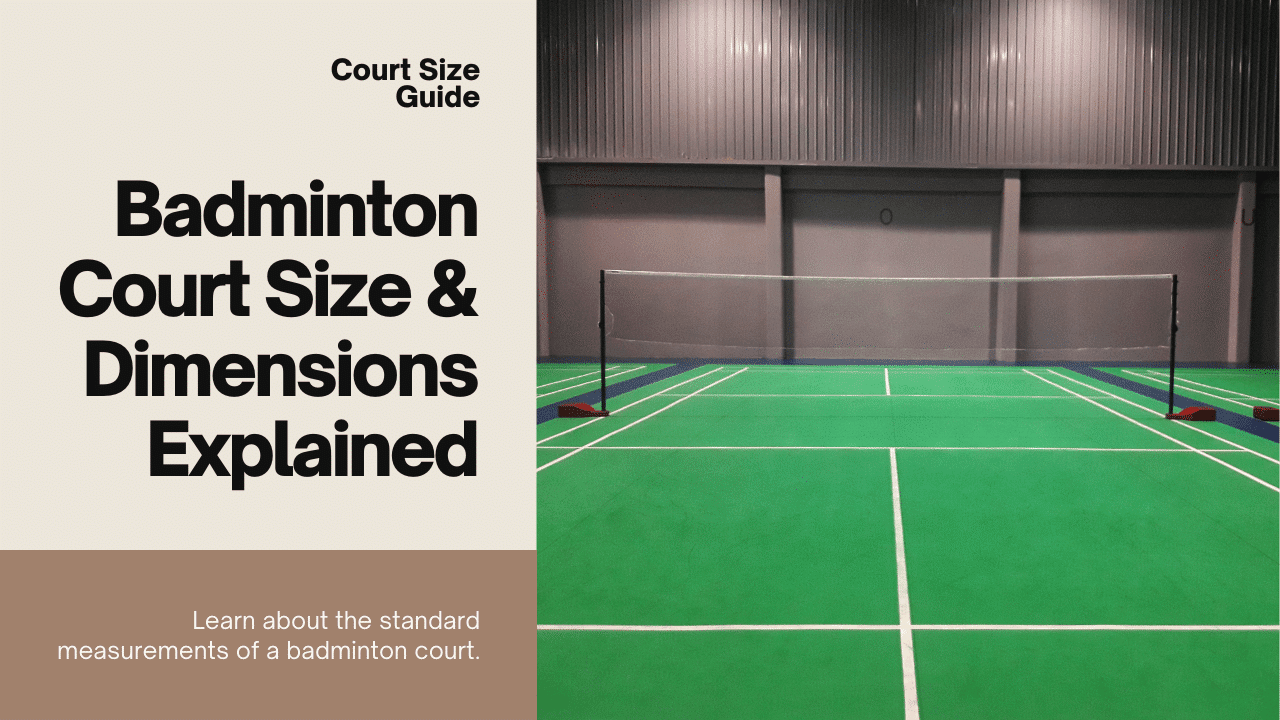Badminton requires a dedicated playing ground with specific markings. It is known as a ‘Badminton Court’.
As a beginner badminton player, you must thoroughly understand the making of a court. Doing so will avoid causing faults like stepping over the service area or hitting the shuttlecock beyond the court area.
In this article, we will cover the components of a badminton court, its dimensions for both singles and doubles play, the area of the court, service lines, net and poles, and more.

Components of a Badminton Court
There are three main components of a badminton court:
- Service Lines
- Boundaries
- Net and Poles
We will look into all of this in detail, including the entire area of a badminton court and its surroundings.
Court Dimensions
The Badminton court has different dimensions for a singles and a doubles game. It is mandatory to draw both courts to overlap each other. You cannot simply build a singles court, you need to build both sets together.
Dimensions for Singles Court
A singles badminton court is narrower than a doubles court, but all the remaining aspects are almost similar, with a few changes.
In Feet : A singles badminton court is 44 feet in length and 17 feet in width.
In Meters: It is approximately 13.4 meters long and 5.18 meters wide in metric measurements.
Dimensions for Doubles Court
A doubles court is wider as more space is required to accommodate two players playing side by side.
In Feet: The dimensions of a doubles badminton court are 44 feet in length and 20 feet in width.
In Meters: In metric measurements, it is about 13.4 meters long and 6.1 meters wide.

Area of a Badminton Court
The total area of a badminton court can be calculated by multiplying the length and width of the court. Here’s the breakdown.
Area for Singles Court:
Area (in feet) = Length (in feet) x Breadth (in feet)
= 44 feet x 17 feet
= 748 square feet
Area (in meters) = Length (in meters) x Breadth (in meters)
= 13.4 meters x 5.18 meters
= 69.46 square meters
Badminton Singles: All You Need to Know
Area for Doubles Court:
Area (in feet) = Length (in feet) x Breadth (in feet)
= 44 feet x 20 feet
= 880 square feet
Area (in meters) = Length (in meters) x Breadth (in meters)
= 13.4 meters x 6.1 meters
= 82.4 square meters
Badminton Doubles: All You Need to Know
Service Lines
There are two service lines on each badminton court.
- Short Service Line (located just behind the net)
- Long Service Line (located at the back of the court)
While delivering a service, you have to stand in the area marked between these two lines. If you step on one of these lines or your foot goes beyond these lines while serving, it is considered a fault.
Singles Court Service Line
In a singles court, the short service line is located at 1.98 meters (6.5 feet) from the net. The long service line is located 6.7 meters (22 feet) from the net. Here, the long service line also acts as the boundary of the singles court.
Area of each service area = (Distance between the short and long service lines x Width of the court) / 2
= (15.5 feet x 17 feet) / 2
= (263.5 square feet) / 2
= 131.75 square feet
Doubles Court Service Line
In a doubles court, the short service line is located the same as in the singles court. It is 1.98 meters (6.5 feet) from the net. But the long service line is 0.35 meters (1.15 feet) from the outer boundary of the court. So, the long service line is 6.35 meters (20.8 feet) from the net.
Area of each service area = (Distance between the short and long service lines x Width of the court) / 2
= (14.35 feet x 20 feet) / 2
= (287 square feet) / 2
= 143.5 square feet
Net and Poles
A net is placed exactly at the center of a court. It divides the entire court into two halves of 22 feet each. The net is fine mesh stretched across the entire width of the court. It is typically made of dark, thin twine or synthetic fiber.
The height of the net should be exactly 1.55 meters (5.1 feet) at the center. It slopes towards the sides a little. That’s why, on either side, the height is 1.524 meters (5 feet). The net should never be straight but always have this slope.
This net is tied to poles placed exactly on the doubles sidelines. The height of these poles should be at least 5.1 feet.
Different types of badminton nets
Indoor Badminton Nets: These nets can be used to reduce the wind’s effects on the shuttle or when hitting it. These indoor nets not only look great but are easy to install.
Outdoor Badminton Net: Made of durable and high-quality materials, these nets can with stands and are perfect for outdoor tournaments and matches. Outdoor nets are placed vertically in the ground and fixed to stakes. These outdoor nets are a great investment for long time players
Portable Badminton Nets: These nets are ideal for recreational activities. These nets are easily uprooted, and can be placed on any surface. These nets have been made from high-quality vinyl and nylon strands. They are stable, long-lasting, and suitable. These nets are also affordable and durable. You can also carry it easily from one location to another. So must recommended these portable nets.
In Feet, Height of a Badminton Net from the Ground
20 feet is the width of a net, and is 5 feet 1 inch long is height of the pools from the ground, while at the centre its height is 5 feet, 2 feet and 6 inches overall height!
In cm, Badminton Net Height
610 cm long is width of the net, whereas 155 cm long is height of the pools from the ground and when we measures from centre, it is 152.4 cm, 76 cm overall height!
In Inches, Badminton Net Height
30 inches is height of the net, its width is 240 inches, while 60 inches is height of the net at the centre point and the height of the pools is 61 inches from the ground.
Factors Affecting Badminton Net Height
There are various factors that can influence the net height. The first one is the distance the net has to cover. As you may know, a standard badminton court is 6.1m (20 feet) wide. If the posts are further apart – the net has to cover a greater distance.
A longer net would demand more tension to keep that badminton net tight; thus possibly raising its height slightly at the center point.
The type of net posts, also play a role – whether they’re embedded permanently into place or portable ones held down by weighty bases – will have their own effect as well.
Last but not least – the temperature. This only plays a role when your net is permanently installed. During summer the steel rope extends – and shrinks with colder temperatures. So take a look at it every now and then if it still has the correct height.
Tips for Setting Up and Maintaining a Badminton Net
Setting up your badminton net with standard dimensions is the first step to a perfect court. You’ll need length posts strong enough to support the net.
Ensure the net’s top edge is 1.55m – or 5 feet and 1 inch above ground level – this measurement aligns with international standards.
Usually, you will align the net over both posts and fix the position with the two hooks on both sides. Then add the tension with a lashing strap. You will struggle with the correct height without a mechanism to add tension so we recommend not buying cheap here.
Maintenance Tips
A well-maintained badminton net ensures that every training or match goes smoothly without hitches or pauses for repairs. Start by checking the standing base regularly; it should be stable and sturdy at all times.
Store the net at room temperature without too much humidity since that might lead to rust and the net snapping earlier than it needs to.
When rolling up the net – make sure there are no wrinkles or knots.
Last but not least – be careful when handling the net under tension. A steel rope that is under a lot of tension can be very dangerous if it hits you. So always release the tension first.
Building a Court
While building a badminton court, you must follow the above-mentioned set of dimensions strictly. All the lines mentioned above are drawn in a single color – either white or yellow.
These lines must be of equal width throughout the court. You also need to choose the type of flooring material and the lighting around the court. So let’s discuss the material and lighting part.
Material
The surface of the court should ideally be made of a non-slip material. This is to prevent injuries and provide good traction for players’ footwork.
Common materials used for badminton court surfaces include hardwood, synthetic materials, and specialized mats.
Hardwood: Traditional badminton courts use hardwood flooring. They provide the best playing characteristics. However, hardwood is easily prone to damage like skid marks, mold, scratching, etc. So, these become expensive to maintain. That’s why, even though traditionally the best, hardwood is used less often.
Synthetic Materials: Instead of hardwood, synthetic materials are used nowadays. For instance, vinyl composite tiles or acrylic surfaces are great alternatives. They are more durable than hardwood and require less maintenance. They are also more affordable to install. They provide a consistent bounce for the players, which is good for quick movement.
Mats: If you want to build a temporary court which you can remove after the matches, you should consider portable badminton mats. These soft mats give a cushion-like effect and provide a grip so the players won’t skid. You can mark the court on these mats and fold them up when not in use. These are perfect for school gyms to build DIY badminton courts.
Lighting
Proper lighting is essential to ensure visibility and accuracy during gameplay. The lights should be bright and evenly distributed. They shouldn’t create any shadows, sparkle, or sudden illumination in the players’ area of vision.
Professionals prefer LED lights because of their energy efficiency. International badminton federations recommend lights of at least 400 lux for competitive badminton games and at least 300 lux for recreational games.
Clearance Space Outside a Badminton Court
A clearance space is maintained outside a badminton court. This place is for players’ safety so they don’t bump into walls or excited audiences. This court is also a safe space in case of emergencies like a player getting injured.
As a thumb rule, at least 5 to 6 feet of space should be kept clear on all sides of the court.
Badminton Court Ceiling
Professional badminton is always played indoors. We play recreational badminton outside in the garden or on the beach. But that’s not permissible for professional events. There’s a lot of wind outside that can swiftly change the direction of the shuttlecock. To avoid that, it is played indoors.
While a court is designed, care should be taken to ensure that there are no drafts or open spaces like doors or windows near the court. Because wind can interfere with the match.
Also, the ceiling of the court should be at least 8 meters (26.2 feet) high from the ground. In case the shuttlecock travels high in the air, it shouldn’t hit the ceiling. That’s why it is necessary to keep this distance.
Conclusion
Understanding the dimensions of a badminton court is fundamental for players, coaches, and organizers alike. Learning standardized court sizes and configurations is essential for learning the rules of the game. You cannot make changes to these court dimensions for professional games. For leisure games, it doesn’t matter that much.
FAQs
Are there any variations in badminton court dimensions?
Yes, the dimensions of a singles badminton court are different than that of a doubles court. But besides that, the dimensions are standardized for all professional games.
What are the markings on the court besides the boundary lines and service lines?
Besides the boundary lines and service lines, there’s a center line on each side of the court. This creates two halves for each court for the purpose of horizontal service.
What is the budget of a badminton court?
The entire budget of a badminton court cannot be fixed. It depends on the type and quality of materials you are using. Roughly, a synthetic badminton court can range from 130 INR to 300 INR per square foot.
Are Badminton and Volleyball net posts the same?
No, Volleyball net posts are much taller for the taller net height. The way a Volleyball net is tied to it’s posts is different as well. Volleyball nets are more complicated to set up because the net has to be pulled tight there are normally cranks on the side to tighten and hold the net.
What is a Badminton net made out of?
Badminton nets are normally made out of nylon but have been made out of vinyl and polyethylene before that. Even the tape that runs along the top of the net is made from nylon.
